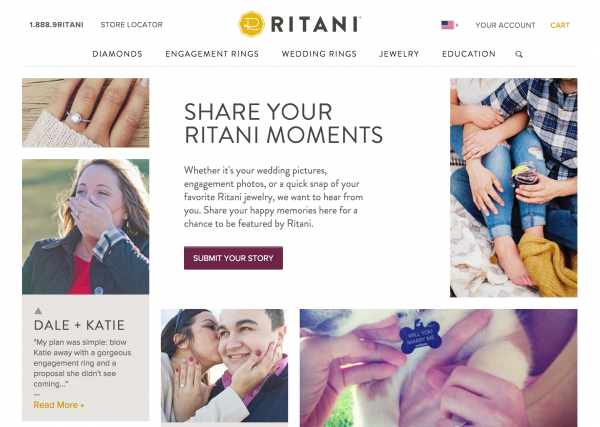Savvy customers are spending more time in the research phase of their online shopping experience – comparing prices, features, shipping costs, and more. It’s called the “zero moment of truth,” that time between identifying a product and making a purchase when a customer is still on the fence about handing over their credit card.
During this time, they’re often seeking out information. Product reviews, testimonials, videos, and anything else that will help them make the right decision.
That’s why savvy e-commerce business owners make sure that information is available.
Case studies are normally thought of as a business-to-business (B2B) marketing tool, rather than a business-to-customer (B2C) tool, but when employed at the “zero moment of truth” they can have a huge effect.
How?
1. Case studies build trust
One of the biggest benefits of using case studies is that they show off the point of view of happy customers – not your company. You can write as many promotional videos, blog posts, and how to guides as you like to show how great your product is, but because they’re from your company’s point of view, a potential customer will take it all with a grain of salt.
But in a case study – or customer success story – your point of view takes a backseat while your customers gush on and on about how great your product is.
Even though the case studies are coming from your company, they’re perceived as a peer-to-peer interaction. Customers who read them don’t think, “The company wants me to think this.” Instead, they think, “Oh, neat, here’s a story from a person just like me.”
Take it from engagement ring company Ritani. Rather than telling customers that they’ll have the perfect engagement story if they buy a Ritani ring, the company has a section on their website showcasing proposal stories. It perfectly fits with their clientele, who want to read how others’ magical moment happened, and it subtly weaves in their message: With Ritani, you get the perfect ring that makes the moment even more special.

2. Case studies take it further than testimonials
You may already have testimonials on your website – and if so, you’re probably wondering why you should bother with case studies. It’s true, they’re very similar. Both serve the same purpose: to let your customers know that your product has solved the problems of other people like them.
But whereas testimonials are brief moments of praise for your product or service, case studies take it deeper. That makes them especially great for businesses that have more expensive products or services that require more research before making the sale – particularly if you’re making claims that using your product or service will be transformative for a customer.
Case studies aren’t just for expensive products, though – they can work for all sorts of things. Take Swiffer, for example. Household cleaning products have been using the formula of showing someone using their product to get better/faster/more thorough results since the dawn of advertising. Swiffer’s take is to present the story of an actual customer – say, Jerry Bell II of Hillsboro, Oregon – in the traditional case study format of Problem —> Solution —> Results. Add in Jerry’s adorable son, and you have a pretty compelling reason to buy a WetJet.

3. Case studies tell stories
One reason case studies really work is that they tell stories. In the case of Jerry Bell II and Swiffer, the 30-second ad tells the story of a single dad cleaning up the messes of his high-energy son – a task which is made easier with the arrival of his new Swiffer WetJet. As a result, Jerry can clean up faster, and engage in some “deep couch sitting.”
It’s basically a short story with a beginning, middle, and end. Or, in case study language, the Problem, Solution, and Result.
- The Problem is the sorry state of affairs your customer is in before they have your product.
- The Solution is your product or service.
- The Result is how fantastic life is now.
4. Case studies get specific
I’m sure you’ve already given some thought to the value proposition of your product or service. Does it help relieve pain or discomfort? Give people’s pets a better night’s sleep? Make entertaining guests a breeze? Grow your clients’ incomes?
In most of your marketing, you may be focusing on the big picture of what your product does – casting your net wide to appeal to as many people as necessary. The problem with that is it can often be difficult for people to visualize just how they would use your product.
That’s the beauty of case studies. They let you narrow in on a specific use case of your product or service – but instead of making your product seem narrowly focused, they tend to unlock potential customers’ imaginations. It helps pin down just how they would use your product – even if it would be in a very different way than the case study subject.
5. Case studies build social proof
The fact that your customers love your product and are willing to go on record saying that provides fantastic social proof. With so many options, many consumers rely on word-of-mouth when making decisions. Reading a case study on your website may not be the same thing as having their best friend recommend your product, but it’s still quite powerful.

IKEA has been focusing on building the social proof through telling their customers’ success stories. The Home Tour Series has been a hugely popular way to show the design problems individual customers face, and how IKEA solutions were able to come to the rescue. While one home tour would have been impressive, IKEA provides overwhelming social proof by showcasing customer case studies from all walks of life.
However you use them, case studies can help you cut through the marketing clutter and to truly connect with your customer.
Are you using case studies on your e-commerce site? Let us know how in the comments!

